Don Gentile liked to go fast. He had a reputation with the police in his home town of Piqua, in western Ohio for having a lead foot. Don got the flying bug when he was still in school, earned a private pilot’s license and his Italian immigrant parents bought him a small biplane which he buzzed the town with until joining the Royal Canadian Air Force in September 1940.
Don was sent to England after earning his wings in November 1941 and was first assigned as an instructor—not exactly the front line combat outfit he had hoped for. By buzzing a dog race he managed to get transferred to No. 133 Eagle Squadron where he flew Spitfires in combat. Don scored two confirmed victories with the 133 Squadron over Dieppe and then transferred to the 4th Fighter Group the following month. He continued to hone his skills as a fighter pilot throughout the next year during which time the 4th switched from the nimble Spitfire to the big, powerful P-47 Thunderbolt.
He finally scored again on 5 January 1944 and only nine days later he shot down his fourth and fifth enemy planes. He became an ace that day but was nearly killed before he could get home to celebrate. “That fight was, perhaps the most critical I have ever fought.” He later commented. “I have had bigger triumphs, easier ones, but this one taxed every last bit of me. It showed me what I had learned and taught me what I was.”
Eighth Bomber Command had intended to attack strategic targets in Germany that day but foul weather in Germany forced them to alter their plans. The skies over France were clear so the mission for the day was changed to a “No Ball” mission; code name for attacks on V-weapon sites in the Pas de Calais area of France. 8th Fighter Command’s job was to provide an aerial umbrella for the attacking bombers.
At Debden a pilots’ briefing was held at 1245 hours. Their mission was a Free Lance (fighter sweep) under type 16 control. The type 16 ground control of airborne fighters system utilised high definition radars located on the coast of England and had an operational range of about 120 miles. The controller’s display screen showed all air activity within that range. After the briefing Don caught a ride to his aircraft, a P-47D named “Donny Boy” which wore a Walt Disney designed cartoon boxing eagle on its nose. After chatting with his crew chief John Ferra and a quick kick of the tires, Captain Gentile climbed aboard. Sergeant Ferra strapped him in and on the order to “Press” Don coaxed the big radial engine to life. On this mission he led Blue flight. His wingman, Lt. Bob Richards was Blue 2. The second element, Lt. Louis “Red Dog” Norley, flying Blue 3 with Lt. Vermont Garrison on his wing in Blue 4 made up the rest of the flight. Group Operations Officer Lt. Col. Sel Edner led the 4th that day. The group crossed the enemy coast near Boulogne
Don was sent to England after earning his wings in November 1941 and was first assigned as an instructor—not exactly the front line combat outfit he had hoped for. By buzzing a dog race he managed to get transferred to No. 133 Eagle Squadron where he flew Spitfires in combat. Don scored two confirmed victories with the 133 Squadron over Dieppe and then transferred to the 4th Fighter Group the following month. He continued to hone his skills as a fighter pilot throughout the next year during which time the 4th switched from the nimble Spitfire to the big, powerful P-47 Thunderbolt.
He finally scored again on 5 January 1944 and only nine days later he shot down his fourth and fifth enemy planes. He became an ace that day but was nearly killed before he could get home to celebrate. “That fight was, perhaps the most critical I have ever fought.” He later commented. “I have had bigger triumphs, easier ones, but this one taxed every last bit of me. It showed me what I had learned and taught me what I was.”
Eighth Bomber Command had intended to attack strategic targets in Germany that day but foul weather in Germany forced them to alter their plans. The skies over France were clear so the mission for the day was changed to a “No Ball” mission; code name for attacks on V-weapon sites in the Pas de Calais area of France. 8th Fighter Command’s job was to provide an aerial umbrella for the attacking bombers.
At Debden a pilots’ briefing was held at 1245 hours. Their mission was a Free Lance (fighter sweep) under type 16 control. The type 16 ground control of airborne fighters system utilised high definition radars located on the coast of England and had an operational range of about 120 miles. The controller’s display screen showed all air activity within that range. After the briefing Don caught a ride to his aircraft, a P-47D named “Donny Boy” which wore a Walt Disney designed cartoon boxing eagle on its nose. After chatting with his crew chief John Ferra and a quick kick of the tires, Captain Gentile climbed aboard. Sergeant Ferra strapped him in and on the order to “Press” Don coaxed the big radial engine to life. On this mission he led Blue flight. His wingman, Lt. Bob Richards was Blue 2. The second element, Lt. Louis “Red Dog” Norley, flying Blue 3 with Lt. Vermont Garrison on his wing in Blue 4 made up the rest of the flight. Group Operations Officer Lt. Col. Sel Edner led the 4th that day. The group crossed the enemy coast near Boulogne
Don with his P-47 nose art. Two victories on the scoreboard indicate this photo was taken before the January 5th, 1944 mission when he shot down a single FW 190.
at 1428 hours. As instructed they arrived at Margny, the rendezvous point. A port orbit was made and the pilots had picked up a southerly heading at an altitude of 18,000 feet when Captain Gentile spotted 15 Fw-190s about 3,000 feet below heading east. As Don took his flight down into the attack, the enemy formation split up and turned to face the diving Thunderbolts. Picking out a pair, Don squinted into the gun sight and held his course in a deadly game of chicken. He later described the sensation. “At 700 miles an hour you can eat up all the distance in one gulp, but while you’re doing it, it seems slow. You can think of a thousand things, and nothing seems to be happening in your life except that the plane is coming slowly toward you and you’re living a lifetime—as if it was a sped-up movie reel—and aging fast and growing older and looking suddenly at the end of your life in just about the time it takes to say it.”
The Germans chickened out first and broke off, diving away to Don’s left. He put the nose of his heavy fighter down and closed the distance rapidly to about 300 yards before he gave the number two Focke Wulf a long squirt from his machine guns. The Nazi machine was hit in the cockpit area and trailed an 8,000 foot plume of smoke before impacting into an open field. Kicking right rudder, Gentile pulled onto the tail of the leader. The German took him down to the deck as Don peppered away at him with resulting flashes blooming from the engine and cockpit of the doomed German. “As I was trying to follow him down in his slipstream to get another shot, he hit the woods and I pulled out just missing the woods myself.”
Just as he was pulling out, Gentile was set upon by another pair of 190s. His wingman and the rest of Blue flight were nowhere to be seen. They had been attacked while Don pursued his second victim and in the ensuing combat they shot down three FW 190s. This however, left Don alone and down on the deck. He was cornered.
“The lead Hun was close enough to me when he started to fire for me to hear the ripped-out chugging of his machine guns and the soft poom-poom-poom of his cannon. There was this sound, and at the same time tracers were going by me and my plane was starting to splinter around me. As I turned my head, I saw a 20 millimetre shell go through my wing and saw the metal of the wing flower and open like a torn mouth and saw my tail quaking and shuddering with animal movements under the blows of more cannon shells.” Gentile was in a pickle; if he tried to climb he would get nailed for sure. All he could do was turn and skid his P-47 around in an effort to keep from presenting an easy target for the 190s. Eventually he shook off one of the 190s but the other persisted. With his throttle wide open, Gentile used full rudder deflection, making flat turns that kept him right on the edge of a spin. “The best I could do with my turns was keep him part way off my tail and give him deflection shots at me. That is, keep my line of flight at an angle to
The Germans chickened out first and broke off, diving away to Don’s left. He put the nose of his heavy fighter down and closed the distance rapidly to about 300 yards before he gave the number two Focke Wulf a long squirt from his machine guns. The Nazi machine was hit in the cockpit area and trailed an 8,000 foot plume of smoke before impacting into an open field. Kicking right rudder, Gentile pulled onto the tail of the leader. The German took him down to the deck as Don peppered away at him with resulting flashes blooming from the engine and cockpit of the doomed German. “As I was trying to follow him down in his slipstream to get another shot, he hit the woods and I pulled out just missing the woods myself.”
Just as he was pulling out, Gentile was set upon by another pair of 190s. His wingman and the rest of Blue flight were nowhere to be seen. They had been attacked while Don pursued his second victim and in the ensuing combat they shot down three FW 190s. This however, left Don alone and down on the deck. He was cornered.
“The lead Hun was close enough to me when he started to fire for me to hear the ripped-out chugging of his machine guns and the soft poom-poom-poom of his cannon. There was this sound, and at the same time tracers were going by me and my plane was starting to splinter around me. As I turned my head, I saw a 20 millimetre shell go through my wing and saw the metal of the wing flower and open like a torn mouth and saw my tail quaking and shuddering with animal movements under the blows of more cannon shells.” Gentile was in a pickle; if he tried to climb he would get nailed for sure. All he could do was turn and skid his P-47 around in an effort to keep from presenting an easy target for the 190s. Eventually he shook off one of the 190s but the other persisted. With his throttle wide open, Gentile used full rudder deflection, making flat turns that kept him right on the edge of a spin. “The best I could do with my turns was keep him part way off my tail and give him deflection shots at me. That is, keep my line of flight at an angle to
Captain Don Gentile and his assistant crew chief Dick Mansfield. Photo: Lee Mansfield
Captain Gentile gained one more victory in the P-47 before the group transitioned to the P-51 Mustang in February 1944. The greater range of the P-51 meant that the Germans could no longer wait beyond the range of escorting American fighters and attack the bomber formations with relative impunity. With a Mustang Gentile’s score began to rise swiftly and when he teamed up with John Godfrey they formed a legendary combat team whose successes have never been equalled. The above story is an excerpt from the chapter on Don Gentile in "Adventures of the 4th Fighter Group" by Troy White.
Captain Gentile with a brand new P-51B Mustang. Gentile was originally was credited with 23 air and 6 ground victories. That score was later reduced to 21.83 air and six ground victories. Gentile earned America's second highest award, the Distinguished Service Cross, twice. Photo: Association of the 4th Fighter Group
Distinguished Service Cross Awarded for actions during WWII
The President of the United States of America, authorised by Act of Congress, July 9, 1918, takes pleasure in presenting the Distinguished Service Cross to Captain (Air Corps) Dominic "Don" S. Gentile (ASN: 0-885109), United States Army Air Forces, for extraordinary heroism in connection with military operations against an armed enemy while serving as Pilot of a P-51 Fighter Airplane in the 336th Fighter Squadron, 4th Fighter Group, EIGHTH Air Force, in aerial combat against enemy forces on 8 March 1944, in the European Theatre of Operations. On this date Captain Gentile, while leading a section of Fighter Aircraft on a bomber escort mission to targets in the vicinity of Berlin, Germany, saw a flight of bombers being attacked by approximately fifty enemy fighters. With only his wing man as support and without regard to the overwhelming odds against him, Captain Gentile immediately attacked the enemy formation and by extremely courageous flying and skilful gunnery destroyed three enemy planes and broke up the threat against the bombers. Continuing with his wing man, they destroyed three more enemy fighters. By this time the wing man had expended his ammunition and Captain Gentile's supply was very low. Despite this fact, they picked up a straggling bomber and escorted it to friendly territory. Captain Gentile's outstanding courage and determination to destroy the enemy on this occasion set an example of heroism which will be an inspiration to the Armed Forces of the United States.
General Orders: Headquarters, U.S. Strategic Forces in Europe, General Orders No. 36 (June 12, 1944)
Action Date: 8-Mar-44
Service: Army Air Forces
Rank: Captain
Company: 336th Fighter Squadron
Regiment: 4th Fighter Group
Division: 8th Air Force
Distinguished Service Cross Awarded for actions during WWII
(Citation Needed) - SYNOPSIS: Captain (Air Corps) Dominic "Don" S. Gentile (ASN: 0-885109), United States Army Air Forces, was awarded a Bronze Oak Leaf Cluster in lieu of a Second Award of the Distinguished Service Cross for extraordinary heroism in connection with military operations against an armed enemy while serving as Pilot of a P-51 Fighter Airplane in the 336th Fighter Squadron, 4th Fighter Group, EIGHTH Air Force, in aerial combat against enemy forces on April 8, 1944. On this date Captain Gentile destroyed three enemy fighters and assisted in destruction of a fourth in a single engagement. Captain Gentile's unquestionable valour in aerial combat is in keeping with the highest traditions of the military service and reflects great credit upon himself, the 8th Air Force, and the United States Army Air Forces.
General Orders: Headquarters, U.S. Strategic Forces in Europe, General Orders No. 23 (1944)
Action Date: 8-April-44
Service: Army Air Forces
Rank: Captain
Company: 336th Fighter Squadron
Regiment: 4th Fighter Group
Division: 8th Air Force
The President of the United States of America, authorised by Act of Congress, July 9, 1918, takes pleasure in presenting the Distinguished Service Cross to Captain (Air Corps) Dominic "Don" S. Gentile (ASN: 0-885109), United States Army Air Forces, for extraordinary heroism in connection with military operations against an armed enemy while serving as Pilot of a P-51 Fighter Airplane in the 336th Fighter Squadron, 4th Fighter Group, EIGHTH Air Force, in aerial combat against enemy forces on 8 March 1944, in the European Theatre of Operations. On this date Captain Gentile, while leading a section of Fighter Aircraft on a bomber escort mission to targets in the vicinity of Berlin, Germany, saw a flight of bombers being attacked by approximately fifty enemy fighters. With only his wing man as support and without regard to the overwhelming odds against him, Captain Gentile immediately attacked the enemy formation and by extremely courageous flying and skilful gunnery destroyed three enemy planes and broke up the threat against the bombers. Continuing with his wing man, they destroyed three more enemy fighters. By this time the wing man had expended his ammunition and Captain Gentile's supply was very low. Despite this fact, they picked up a straggling bomber and escorted it to friendly territory. Captain Gentile's outstanding courage and determination to destroy the enemy on this occasion set an example of heroism which will be an inspiration to the Armed Forces of the United States.
General Orders: Headquarters, U.S. Strategic Forces in Europe, General Orders No. 36 (June 12, 1944)
Action Date: 8-Mar-44
Service: Army Air Forces
Rank: Captain
Company: 336th Fighter Squadron
Regiment: 4th Fighter Group
Division: 8th Air Force
Distinguished Service Cross Awarded for actions during WWII
(Citation Needed) - SYNOPSIS: Captain (Air Corps) Dominic "Don" S. Gentile (ASN: 0-885109), United States Army Air Forces, was awarded a Bronze Oak Leaf Cluster in lieu of a Second Award of the Distinguished Service Cross for extraordinary heroism in connection with military operations against an armed enemy while serving as Pilot of a P-51 Fighter Airplane in the 336th Fighter Squadron, 4th Fighter Group, EIGHTH Air Force, in aerial combat against enemy forces on April 8, 1944. On this date Captain Gentile destroyed three enemy fighters and assisted in destruction of a fourth in a single engagement. Captain Gentile's unquestionable valour in aerial combat is in keeping with the highest traditions of the military service and reflects great credit upon himself, the 8th Air Force, and the United States Army Air Forces.
General Orders: Headquarters, U.S. Strategic Forces in Europe, General Orders No. 23 (1944)
Action Date: 8-April-44
Service: Army Air Forces
Rank: Captain
Company: 336th Fighter Squadron
Regiment: 4th Fighter Group
Division: 8th Air Force
Blog lead off image: "Help! I'm Being Clobbered!" Oil on Canvas 30" x 40" © Troy White 2010 FOR SALE Contact me for price.
This painting is from the Rotational series.
For canvas prints click here or click on the shop button below.
This painting is from the Rotational series.
For canvas prints click here or click on the shop button below.
Help, I'm Being Clobbered!
$165.00
Open Edition Canvas Giclée Print. Image size: 15"x20"
Captain Don Gentile is depicted taking evasive action over France in this fully rotational image. On 14 January 1944 Gentile shot down two German aircraft but narrowly escaped with his life when he was jumped by enemy fighters.
Captain Don Gentile is depicted taking evasive action over France in this fully rotational image. On 14 January 1944 Gentile shot down two German aircraft but narrowly escaped with his life when he was jumped by enemy fighters.
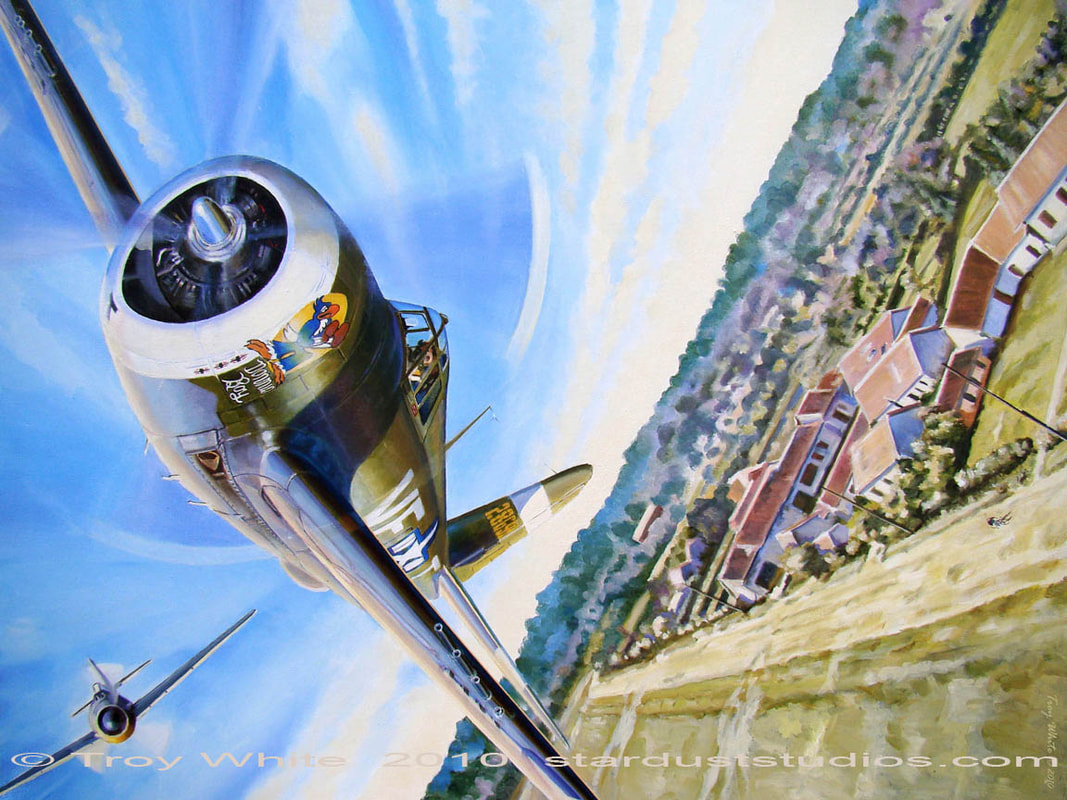
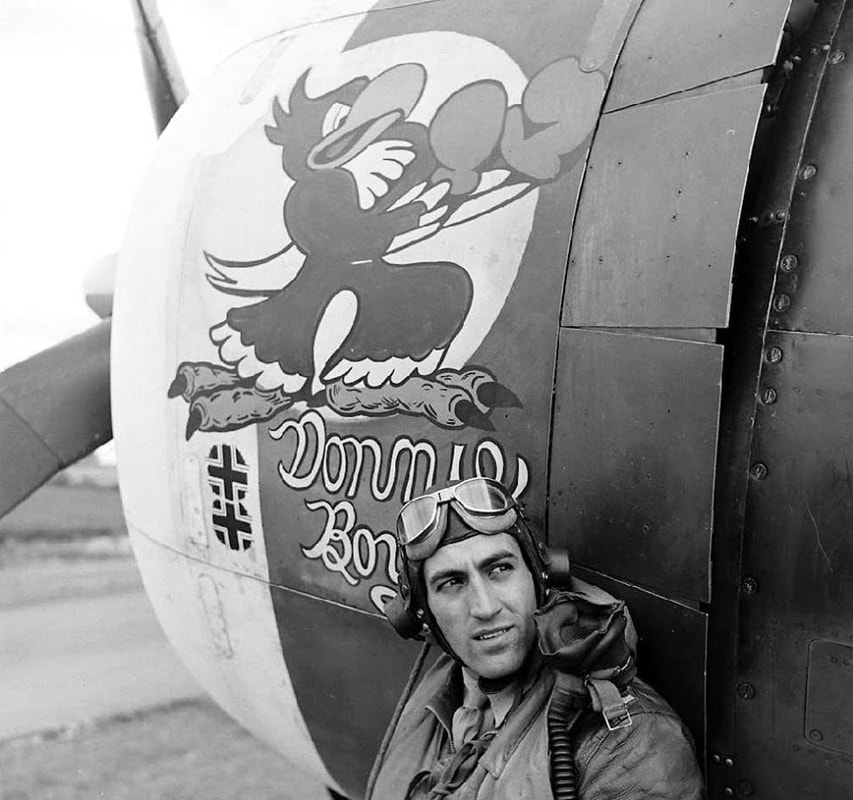
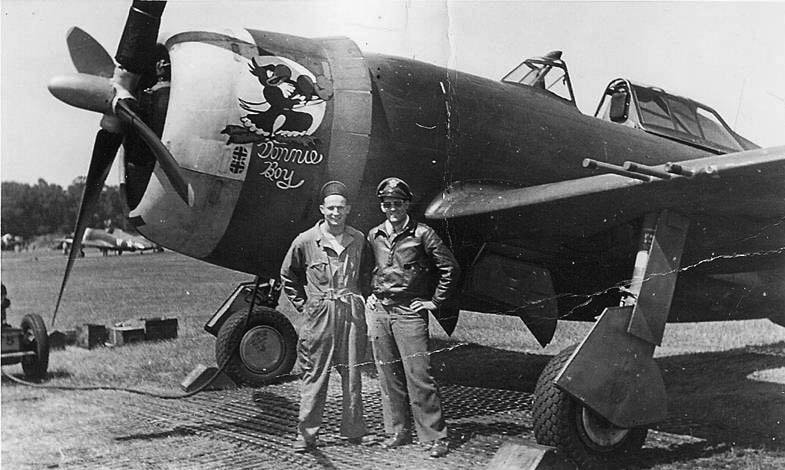
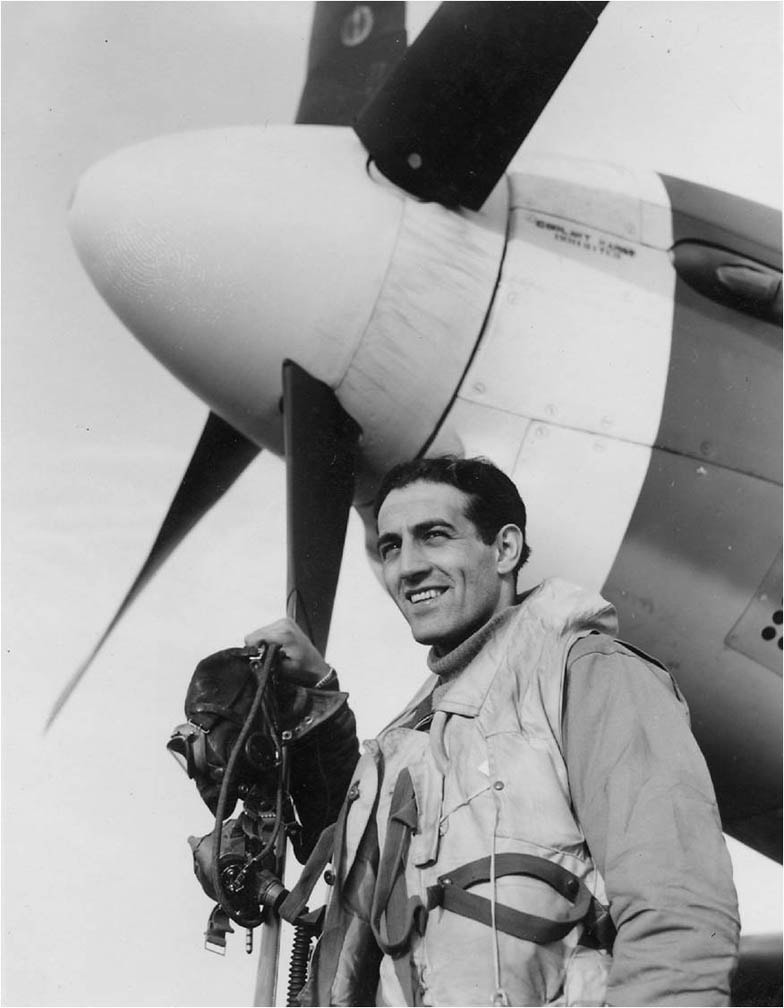
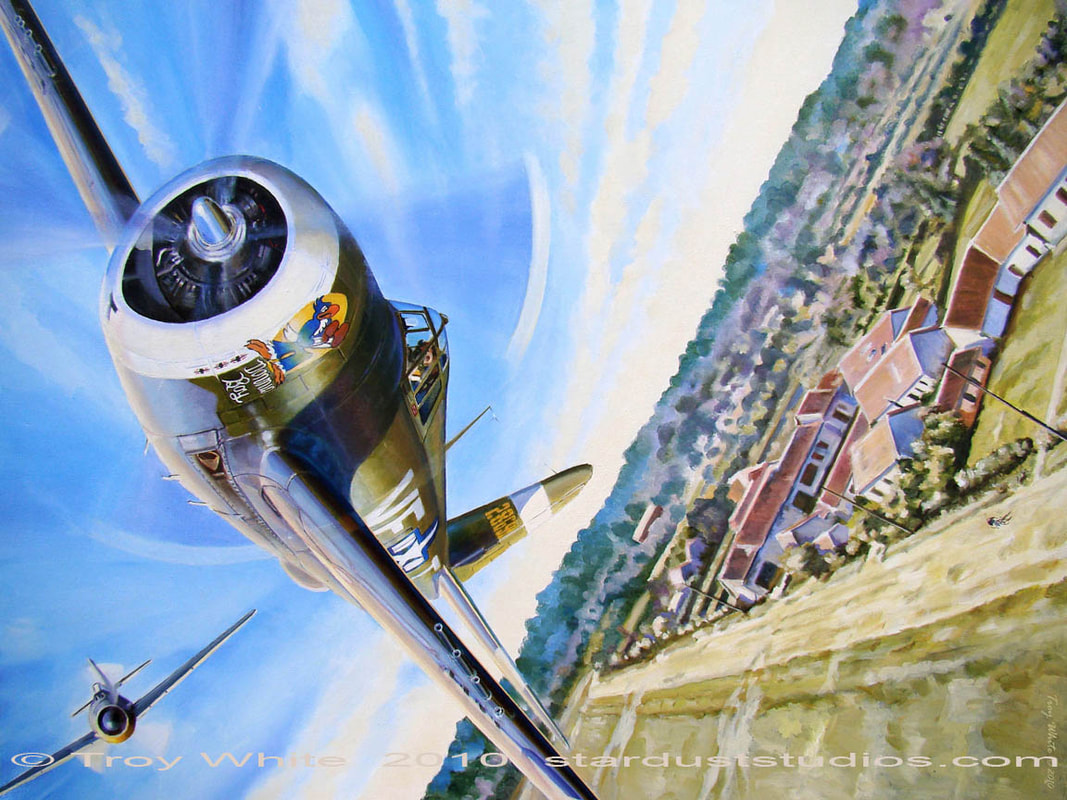
 RSS Feed
RSS Feed

